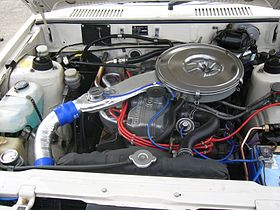Astron 2.6
| 4G5 | |
|---|---|

Mitsubishi G54B engine
|
|
| Overview | |
| Manufacturer | Mitsubishi Motors |
| Also called | Astron |
| Production | 1972–present |
The Mitsubishi Astron or 4G5 engine, is a series of straight-four internal combustion engines first built by Mitsubishi Motors in 1972. Engine displacement ranged from 1.8 to 2.6 litres, making it one of the largest four-cylinder engines of its time. It became the first Japanese production engine to combine both electronic fuel injection (EFI) and turbocharging.
It employed a hemispherical cylinder head, chain-driven single overhead camshaft (SOHC) and eight valves (two per cylinder). United States passenger car versions had a small secondary intake valve referred to as the "Jet Valve". This valve induced swirl in the intake charge, enabling the use of leaner fuel/air mixtures for lower emissions. It was designed as a cartridge containing the valve spring and seat which simply screwed into a threaded hole in the head, similar to a spark plug but inside the cam cover. The rocker arms for the intake valve were widened on the valve end to accommodate the cartridge, which was equipped with a very soft valve spring in order to avoid wear on the camshaft intake lobe. Modifications to the head were thereby reduced as the Jet Valve negated the necessity for a three-valve-per-cylinder design.
In 1975, the Astron 80 introduced a system dubbed "Silent Shaft": the first use of twin balance shafts in a modern engine. It followed the designs of Frederick Lanchester, whose original patents Mitsubishi had obtained, and proved influential as Fiat/Lancia, Saab and Porsche all licensed this technology.
...
Wikipedia
